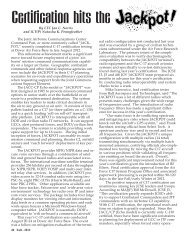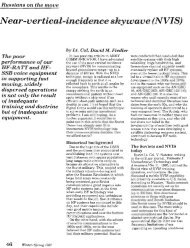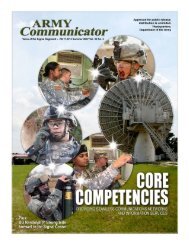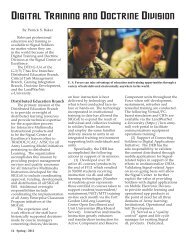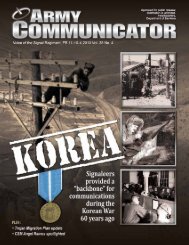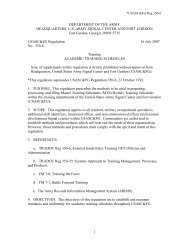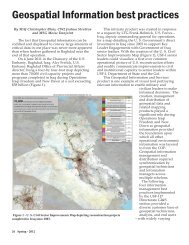AC Summer 08 WIN-T Online - United States Army Signal Center of ...
AC Summer 08 WIN-T Online - United States Army Signal Center of ...
AC Summer 08 WIN-T Online - United States Army Signal Center of ...
You also want an ePaper? Increase the reach of your titles
YUMPU automatically turns print PDFs into web optimized ePapers that Google loves.
Figure 2.<br />
link to an RHN. APCs will<br />
provide fixed platforms in sanctuary<br />
locations at which user servers and<br />
applications can be hosted. This<br />
arrangement will allow the prepositioning<br />
<strong>of</strong> battle command and<br />
common user services to give<br />
warfighters immediate access to<br />
needed services. When available,<br />
servers at these facilities can be preloaded<br />
with battle command<br />
applications, standard operating<br />
systems, patches, and security<br />
configurations required by operational<br />
units.<br />
Units arriving in theater will<br />
be able to obtain network services<br />
without employing an organic hub<br />
node. RHNs and APCs will support<br />
continuity <strong>of</strong> operation during those<br />
times when a supported unit’s<br />
organic hub node is not operational.<br />
Using NSC capabilities, units will be<br />
able to gain access quickly to<br />
network services as they maneuver<br />
and relocate command posts. NSC<br />
facilities will also serve as a vital<br />
backup capability in the event a<br />
unit’s organic hub node fails. In<br />
cases where operational requirements<br />
exceed the capacity <strong>of</strong> a unit’s<br />
organic hub node, an RHN hub<br />
node can accommodate the over-<br />
64 <strong>Summer</strong> 20<strong>08</strong><br />
flow.<br />
As the network is extended,<br />
TNOSCs will oversee technical<br />
management <strong>of</strong> the network,<br />
coordinate the provisioning <strong>of</strong><br />
services, and provide the governance<br />
security oversight required to<br />
give the warfighter a high level <strong>of</strong><br />
service availability.<br />
Bringing the concept to reality<br />
Portions <strong>of</strong> the NSC construct<br />
exist today and others are coming<br />
on line as funds become available.<br />
Regional hub nodes are ready<br />
to go into full service in Kuwait and<br />
Germany. Additional hubs are<br />
slated for construction at east and<br />
west coast locations in the <strong>United</strong><br />
<strong>States</strong>, and a fifth hub will be built<br />
in the Pacific region. A sixth hub,<br />
for training, located at Fort Gordon,<br />
has been in operation for more than<br />
a year. In addition to supporting<br />
operator training at the <strong>Signal</strong><br />
School, the training hub provides<br />
network services to units training at<br />
sites as far away as Alaska and<br />
Hawaii, demonstrating to commanders<br />
that they can quickly gain<br />
reliable network services without<br />
deploying their own hub.<br />
APCs have also begun to<br />
appear in the <strong>United</strong> <strong>States</strong> and in<br />
some overseas sites. More APCs<br />
will be built as funds become<br />
available. APC services, to include<br />
capabilities directly aimed at<br />
supporting deployed operational<br />
units, will continue to be explored.<br />
At the same time, upgrades to<br />
TNOSC capabilities will be incorporated<br />
to improve the ability to<br />
manage network operations across<br />
an enterprise that connects operational<br />
and generating force activities.<br />
In recent briefings, GEN<br />
George Casey, Chief <strong>of</strong> Staff <strong>of</strong> the<br />
<strong>Army</strong>, has emphasized the critical<br />
importance <strong>of</strong> information in<br />
executing the <strong>Army</strong>’s mission, and<br />
has expressed his intent to expedite<br />
the regional NSC effort. With<br />
support <strong>of</strong> the <strong>Army</strong>’s leadership,<br />
regional NSCs will soon be providing<br />
the expeditionary <strong>Army</strong> a much<br />
needed capability to move information<br />
as quickly as it can deploy<br />
forces.<br />
COL (Ret.) Wells is the author<br />
<strong>of</strong> the Network Service <strong>Center</strong>-<br />
Regional concept. A former Training<br />
and Doctrine Command Systems<br />
manager for the Mobile Subscriber<br />
Equipment system, Wells<br />
works for Janus Research Group,<br />
Inc. supporting the Concepts<br />
Section <strong>of</strong> the <strong>Signal</strong> <strong>Center</strong>’s<br />
Capabilities Development and<br />
Integration Directorate.<br />
<strong>AC</strong>RONYM QUICKSCAN<br />
APC – Area Processing <strong>Center</strong>s<br />
COOP – Continuity <strong>of</strong> Operation<br />
DECC – Defense Enterprise<br />
Computing <strong>Center</strong><br />
DISN – Defense Information<br />
Systems Network<br />
NETOPS – Network Operations<br />
NSC – Network Service <strong>Center</strong><br />
RHN – Regional Hub Node<br />
TNOSC – Theater Network<br />
Operations and Security <strong>Center</strong>



